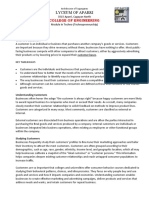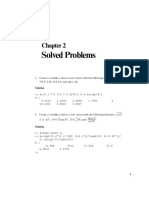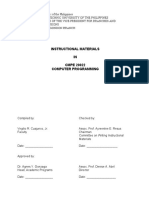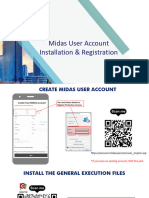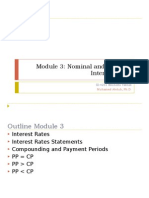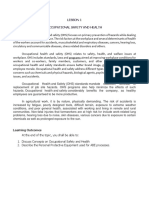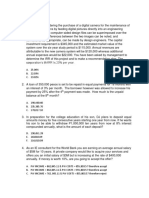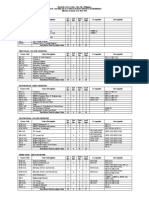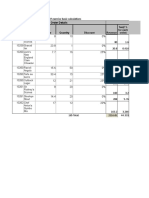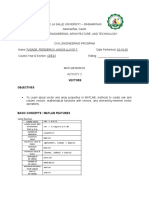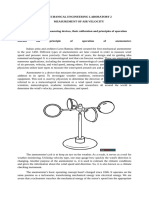TECHNOPRENEURSHIP FINAL Module 3 PDF
TECHNOPRENEURSHIP FINAL Module 3 PDF
Uploaded by
Dryx LetranCopyright:
Available Formats
TECHNOPRENEURSHIP FINAL Module 3 PDF
TECHNOPRENEURSHIP FINAL Module 3 PDF
Uploaded by
Dryx LetranOriginal Title
Copyright
Available Formats
Share this document
Did you find this document useful?
Is this content inappropriate?
Copyright:
Available Formats
TECHNOPRENEURSHIP FINAL Module 3 PDF
TECHNOPRENEURSHIP FINAL Module 3 PDF
Uploaded by
Dryx LetranCopyright:
Available Formats
Technopreneurship
MEEC 107
Lady Mae B. Calderon
Author
1st Semester 2020
Don Mariano Marcos Memorial State
University – Mid La Union Campus
College of Arts And Sciences
DMMMSU - MLUC
Course Outline
Technopreneurship
MEEC 107
Week Course Content / Subject Matter
Week 1 Orientation
1. VGMO
2. Student Handbook
3. Course Content
Week 1-3 Chapter I: Introduction to Technopreneurship
a) What is technopreneurship?
b) Importance of technopreneurship
c) Entrepreneurship vs.Technopreneurship
d) Types of entrepreneurship
e) Characteristics of Entrepreneurship and
technopreneurship
f) What makes entrepreneur a technopreneur?
Chapter II: Small Medium Enterprises (SME)
a) Characteristics of small business
b) Management functions
c) Form of business entities
Week 4-6 Chapter III:Technopreneurship Ecosystem
a) Human Resource Component
b) Environment Component
c) Financial component
d) Common components of technopreneurship
e) The 9 Fs of business
Week 7-9 Chapter IV:SEED Model
a) Self Mastery
b) Environment Mastery
College of Arts And Sciences
DMMMSU - MLUC
c) Enterprise Mastery
d) Development of Business Plan
MIDTERM EXAMINATION
Week 10-11 Chapter V:High - Tech industry
a) Technology Ventures
b) Technopreneur and the economy
c) Successful traits of technopreneur
d) Factors leading to technopreneurial success
Week 12-14 Chapter VI: Legal Stuff
a) Property Rights
b) Registering your business
c) Trade Laws
Week 16-18 Chapter VII: Business Plan Overview
a) What is Business Plan
b) Elements of business plan
c) Introductory Elements
d) Executive Summary
e) Business description
f) Writing a business plan
Chapter VIII: Business Operations and Organizations
a) Identifying Location and Premises
b) Marketing Strategy
c) Ordering processing and inventory control
d) Competition and Buying patterns
Chapter IX: Products and Services
a) Product Descriptions and history
b) Product Life Cycle
c) Product Plan
d) Brochure presentation and impact evaluation
FINAL EXAMINATION
College of Arts And Sciences
DMMMSU - MLUC
Outline 4
COURSE
DESCRIPTION
MIDTERM 60% CS (Recitation, Quizzes, Seatworks, Assignments)
TECHNOPRENEURSHIP subject is designed as an introduction to the rapidly
evolving world on creative new venture in internet marketing. This course intends
to give an understanding of Technopreneurship fundamentals. The topics covered
include marketing in information age, developing business plan, financing and
marketing business, innovation and creativity, financial management, and
products identification. Students will be exposed to various case studies on
successful entrepreneurs such as Bill Gates of Microsoft, Michael Dell of Dell etc.
OBJECTIVES
At the end of the term, the learners should have developed the following
competencies:
1. Explain clearly the concepts of Technopreneurship, business ownership,
creativity and innovative mind in IT business;
2. Manage a business successfully and commit ethical responsibilities in running
a business to ensure sustainable for future expansion;
3. Develop a business plan into successful action plans based on current
technologies and creative a new venture to support the business;
4. Have a thorough understanding of the entrepreneurial process from idea
generation to the structuring of an entrepreneurial venture.
5. Describe the nature and characteristics of Entrepreneurs.
College of Arts And Sciences
DMMMSU - MLUC
Outline 5
40% MIDTERM EXAM
60% CS (Recitation, Quizzes, Seatworks, Assignments)
FINAL GRADE
40% FINAL GRADE
6. Evaluate a business idea against a personal vision – lifestyles, professional
and financial goals
✔ COURSE
REQUIREMENTS
1. Regularly attend the class (online and face-to-face)
2. Have active class participation
3. Take the quizzes and laboratory activities
4. Take and pass the required periodical examination; and
5. Submit the required final project before the end of the term
GRADING SYSTEM
Midterm Grade= CS + Midterm Exam
Final Term Grade = CS + Final Exam
Final Grade = 40% of Midterm Grade + 60% of Final Term Grade
Module III High- Tech Industry
Lesson 1 High - Tech Industry
College of Arts And Sciences
DMMMSU - MLUC
Outline 6
Lesson 2 Legal Stuff
Module IV Business Plan Overview
Lesson 1 What is Business Plan?
Lesson 2 Business Operations and Organizations
Lesson 3 Products and Services
Skrba, A. (2019). What is a Blog?. Retrieved on September 10, 2019 from
firstguide.org: https://firstsiteguide.com/what-is-blog/
GCFLearnFree.org, (n.d.). Internet Basics. Retrieved on November 13, 2017
from GCFLearnFree.org: https://edu.gcfglobal.org/en/internetbasics/
Kohan, B. (2011). Internet History. Retrieved on August 8, 2019 from
Comentum: https://www.comentum.com/internet-history.html
Merchant, S. (2005). Internet and the World Wide Web. Retrieved on November
12,2017fromhttps://www.csus.edu/indiv/m/merchants/l3b_internet&web.ppt
https://www.website.com/beginnerguide/domainnames/8/1/What-is-a-
domain-name?.ws
Mitchell, B. (2019a). Ethernet Cables and How They Work. Retrieved on
September 5, 2019 from Lifewire: https://www.lifewire.com/what-is-an-
ethernet-cable-817548
Mitchell, B. (2019b). Introduction to LANs, WANs, and Other Kinds of Area
Networks. Retrieved on September 5, 2019 from Lifewire:
https://www.lifewire.com/lans-wans-and-other-area-networks-817376
https://www.geeksforgeeks.org/basics-computer-networking/
http://www.differencebetween.net/technology/difference-between-client-
and-server-2/
https://kb.iu.edu/d/aeud
https://techterms.com/definition/macaddress
https://www.ligowave.com/the-difference-between-a-modem-and-a-router
https://medium.com/@fiberstoreorenda/do-you-know-the-difference-
between-hub-switch-router-b74c2e8a8143
https://en.wikipedia.org/wiki/Wireless_router
w3schools.com/html/html_basic.asp
Stair, Ralph M. and Reynolds, George W., Principles of Information Systems, 8th
Edition. (2011). Cengage Learning.
https://techterms.com
College of Arts And Sciences
DMMMSU - MLUC
Outline 7
https://www.gcflearnfree.org/computerbasics
https://www.teach-ict.com/as_as_computing/ocr/H047/F451/311/a_
components_system/miniweb/index.htmt
https://www.quora.com/What-are-the-types-of-application-software
https://searchcio.techtarget.com/definition/software-license
College of Arts And Sciences
DMMMSU - MLUC
Contents 8
Table of Contents
Course Outline 2
Module 3: High- Tech Industry 7
Technology Ventures 9
Technopreneur and the Economy 13
Legal Stuff 17
Property Rights 20
Registering your Business 22
Trade Laws 29
Module 4: Business Plan Overview 39
What is Business Plan 40
Elements of Business Plan 43
Introductory Elements 48
Executive Summary 54
Writing a Business Plan 56
Business Operations and Organizations 69
Identifying Location and Premises 70
Marketing Strategy 72
Ordering Processing and Inventory Control 74
Competition and Buying Patterns 75
College of Arts And Sciences
DMMMSU - MLUC
Contents 9
Products and Services 82
Product Descriptions and history 83
Product Life Cycle 84
Product Plan 85
Brochure presentation and Impact Evaluation 93
College of Arts And Sciences
DMMMSU - MLUC
Module 3 10
Module 3: High- Tech Industry
Technopreneurship
MEEC 107
Lesson 1 Technology Ventures
Lesson 2 Legal Stuff
Lesson 1: High- Tech Industry College of Arts and Sciences
DMMMSU - MLUC
Module 3 11
Lesson 1
High- Tech Industry
Lesson 1: High- Tech Industry College of Arts and Sciences
DMMMSU - MLUC
Module 3 12
Technology Ventures
For the existing enterprise, whether business or public-service institution, the
controlling word in the term “entrepreneurial management” is “entrepreneurial.” For
the new venture, it is “manage
ment.” In the existing business, it is the existing that is the main obstacle to
entrepreneurship. In the new venture, it is its absence. The new venture has an idea.
It may have a product or a service. It may even have sales, and sometimes quite a
substantial volume of them. It surely has costs. And it may have revenues and even
profits. What it does not have is a “business,” a viable, operating, organized
“present” in which people know where they are going, what they are supposed to do,
and what the results are or should be. But unless a new venture develops into a new
business and makes sure of being “managed,” it will not survive no matter how
brilliant the entrepreneurial idea, how much money it attracts, how good its products,
nor even how great the demand for them.
Entrepreneurial management in the new venture has four requirements:
It requires, first, a focus on the market.
THE NEED FOR MARKET FOCUS
A common explanation for the failure of a new venture to live up to its promise
or even to survive at all is: “We were doing fine until these other people came and
took our market away from us. We don’t really understand it. What they offered
wasn’t so very different from what we had.” Or one hears: “We were doing all right,
but these other people started selling to customers we’d never even heard of and all
of a sudden they had the market.”
It requires, second, financial foresight, and especially planning for cash flow and
capital needs ahead.
FINANCIAL FORESIGHT.
Lack of market focus is typically a disease of the “neo-natal,” the infant new
venture. It is the most serious affliction of the new venture in its early
stages—and one that can permanently stunt even those that survive. The lack
of adequate financial focus and of the right financial policies is, by contrast,
the greatest threat to the new venture in the next stage of its growth. It is,
above all, a threat to the rapidly growing new venture. The more successful a
new venture is, the more dangerous the lack of financial
foresight.Entrepreneurs starting new ventures are rarely unmindful of money;
on the contrary, they tend to be greedy. They therefore focus on profits. But
Lesson 1: High- Tech Industry College of Arts and Sciences
DMMMSU - MLUC
Module 3 13
this is the wrong focus for a new venture, or rather, it comes last rather than
first. Cash flow, capital, and controls come much earlier. Without them, the
profit figures are fiction—good for twelve to eighteen months, perhaps, after
which they evaporate.
It requires, third, building a top management team long before the new venture
actually needs one and long before it can actually afford one.
BUILDING A TOP MANAGEMENT TEAM .The new venture has successfully
established itself in the right market and has then successfully found the
financial structure and the financial system it needs. Nonetheless, a few years
later it is still prone to run into a serious crisis. Just when it appears to be on
the threshold of becoming an “adult”—a successful, established, going
concern—it gets into trouble nobody seems to understand. The products are
first-rate, the prospects are excellent, and yet the business simply cannot
grow. Neither profitability nor quality, nor any of the other major areas
performs. The reason is always the same: a lack of top management. The
business has outgrown being managed by one person, or even two people, and
it now needs a management team at the top. If it does not have one already
in place at the time, it is very late—in fact, usually too late. The best one can
then hope is that the business will survive. But it is likely to be permanently
crippled or to suffer scars that will bleed for many years to come. Morale has
been shattered and employees throughout the company are disillusioned and
cynical. And the people who founded the business and built it almost always
end up on the outside, embittered and disenchanted. The remedy is simple:
To build a top management team before the venture reaches the point where
it must have one. Teams cannot be formed overnight. They require long
periods before they can function. Teams are based on mutual trust and
mutual understanding, and this takes years to build up. In my experience,
three years is about the minimum.
And finally, it requires of the founding entrepreneur a decision in respect to his or
her own role, area of work, and relationships.
THE NEED FOR OUTSIDE ADVICE.These last cases point up an important factor
for the entrepreneur in the new and growing venture, the need for
independent, objective outside advice. The growing new venture may not
need a formal board of directors. Moreover, the typical board of directors
very often does not provide the advice and counsel the founder needs. But the
founder does need people with whom he can discuss basic decisions and to
whom he listens. Such people are rarely to be found within the enterprise.
Somebody has to challenge the founder’s appraisal of the needs of the
venture, and of his own personal strengths. Someone who is not a part of the
Lesson 1: High- Tech Industry College of Arts and Sciences
DMMMSU - MLUC
Module 3 14
problem has to ask questions, to review decisions and, above all, to push
constantly to have the long-term survival needs of the new venture satisfied
by building in the market focus, supplying financial foresight, and creating a
functioning top management team. This is the final requirement of
entrepreneurial management in the new venture.
In so many new ventures, especially high-tech ventures, the techniques
discussed in this chapter are spurned and even despised. The argument is that
they constitute “management” and “We are entrepreneurs.” But this is not
informality; it is irresponsibility. It confuses manners and substance. It is old
wisdom that there is no freedom except under the law. Freedom without law
is license, which soon degenerates into anarchy, and shortly thereafter into
tyranny. It is precisely because the new venture has to maintain and
strengthen the entrepreneurial spirit that it needs foresight and discipline. It
needs to prepare itself for the demands its own success will make of it. Above
all, it needs responsibility—and this, in the last analysis, is what
entrepreneurial management supplies to the new venture. There is much
more that could be said about managing the new venture, about financing,
staffing, marketing its products, and so on.
.
Technopreneur and the Economy
Technopreneurship is a process through which individuals and teams bring together
the necessary resources to exploit opportunities and in doing so create wealth, social
benefits and prosperity.
•The role of technopreneur as agent of economic growth.
•The technopreneur must know how to use knowledge to create innovation and new
firms.
•The level of economic prosperity of a nation is determined by the level of
entrepreneurial activity which flows from a combination of entrepreneurial capital
and intellectual capital.
Three elements of the intellectual capital
–Human capital
•The skills, capabilities, and knowledge of the firm’s people.
–Organizational capital
•The patents, technologies, processes, databases and networks
–Social capital
•The quality of the relationships with customers, suppliers and partner
Lesson 1: High- Tech Industry College of Arts and Sciences
DMMMSU - MLUC
Module 3 15
Factors Leading to Technopreneurial success
The most critical and most important key success factors that can make an
entrepreneur become a successful entrepreneur are:
1. Willingness to take action. This is the first and most important factor for “would
be” and current entrepreneurs. All other entrepreneurial key success factors,
are not necessary if you are a person who afraid to take real action. Actions are
something that can lead you to the success. Without actions, you can’t expect to
become a successful business owner. Sorry, it is a fact!
2. Entrepreneurial knowledge. Entrepreneurs are persons who must have superior
knowledge about specific business issues for the business that they have started.
Your knowledge will increase your business potential energy and in large part will
contribute to the success of your company.
3. Entrepreneurial creativity. You must be a creative person if you want to be
unique enough and with the power of continuous improvement in your business.
The creativity will increase your business potential energy that will bring many
possibilities for your company.
4. Entrepreneurial skills. Each entrepreneur and each business will need
different entrepreneurial skills that in some cases can be crucial to the success of
their companies. If you have the knowledge, but you don’t have skills that can be
covered only through implementation of what you have learned, you can’t expect
that you are close to the success. As you can see, you will have skills if you take
action, implementing what you have learned.
5. Entrepreneurial intelligence. You must be intelligent to manage all
possible situations and solve the hardest problems that will be the most
consistent thing in your business life. Your intelligence will additionally bring
uniqueness to your company because it is something that can’t be copied from
others.
6. Patience. You must be patient and ready to continue even you lose the first
battle. It is important because the war is still not finished. This is only the
beginning of your journey as an entrepreneur. You need to understand that
your entrepreneurial journey isn’t an easy journey from A to B.
7. Persistence. Persistence is simply a refusal to give up for something, or ability to
keep your actions against your personal feelings that you’re not ready for these
actions. Feelings and motivation didn’t produce results. The action is something
that will provide the results you want to achieve. So, remove your feelings that
pulled you back, and with the whole power continue on your journey.
8. The ability for teamwork. Nobody can achieve anything alone so, this is also true
for you as an entrepreneur. You are not a “Superman.” As an entrepreneur, you
must be a team player for your own and your business success.
9. Risk taking, but calculated risk. This is indeed one of the most critical questions:
Are entrepreneurs taking enough risk? Yes, each business startup is at some level
risky. However, more important is how a successful entrepreneur takes a risk? The
word calculated risk is the most appropriate word for this characteristic. You
need to use risk management principles if you want to succeed.
Lesson 1: High- Tech Industry College of Arts and Sciences
DMMMSU - MLUC
Module 3 16
10. The self-confidence as a key success factor. Self-confidence is a significant and
key success factor for entrepreneurs. I think that nobody will become an
entrepreneur if he doesn’t have self-confidence in himself, primarily related to
start and manage his own business.
11. To have enough experience. Sometimes experience is in a category not so
required as a factor, but it is something that will increase your business potential
energy. As an entrepreneur, you must employ all present and previous experience
you have in the business that you are building.
12. Great talent. Talent is something inborn in an entrepreneur. But, sometimes
talent is something that can be easily replaced with knowledge and skills.
13. Honesty. Honesty is vital in every case. But sometimes honesty, being real, can
be the most significant enemy of an entrepreneur in some complex conditions.
14. Connections. More connection means more possibilities for building a successful
business.
15. Luck. Luck is a psychological factor. Some people can say that they aren’t lucky
persons. And indeed there are some “lucky people” who just accidentally found
the right place at the right time with the right idea. However, it is a small
percentage and cannot be included as a serious factor for success.
The key success factors on this list are sorted according to their importance to your
success as an entrepreneur. So, the most important key success factor here is your
ability to take action.
Learning Activity
LEARNING ACTIVITY
Interview an entrepreneur in your community. Ask on how the pandemic
affected his/her business. What were the challenges and issues faced by the
entrepreneur? What were their response or their coping mechanisms on the
challenges and issues mentioned?
____________________________________________________________________
____________________________________________________________________
____________________________________________________________________
____________________________________________________________________
____________________________________________________________________
____________________________________________________________________
Lesson 1: High- Tech Industry College of Arts and Sciences
DMMMSU - MLUC
Module 3 17
Lesson 1: High- Tech Industry College of Arts and Sciences
DMMMSU - MLUC
Module 3 18
Lesson 2
Legal Stuff
Module Summative Test College of Arts and Sciences
DMMMSU - MLUC
Module 3 19
Property Rights
Republic Act No. 8293 [An Act Prescribing the Intellectual Property Code and
Establishing the Intellectual Property Office, Providing for Its Powers and Functions,
and for Other Purposes] otherwise known as the Intellectual Property Code of the
Philippines.
State policy declaration:
The State recognizes that an effective intellectual and industrial property system is
vital to the development of domestic and creative activity, facilitates transfer of
technology, attracts foreign investments, and ensures market access for our
products. It shall protect and secure the exclusive rights of scientists, inventors,
artists and other gifted citizens to their intellectual property and creations,
particularly when beneficial to the people, for such periods as provided in this Act.
The use of intellectual property bears a social function. To this end, the State shall
promote the diffusion of knowledge and information for the promotion of national
development and progress and the common good.
It is also the policy of the State to streamline administrative procedures of registering
patents, trademarks and copyright, to liberalize the registration on the transfer of
technology, and to enhance the enforcement of intellectual property rights in the
Philippines.
Effect on international conventions and on principle of reciprocity:
Any person who is a national or who is domiciled or has a real and effective industrial
establishment in a country which is a party to any convention, treaty or agreement
relating to intellectual property rights or the repression of unfair competition, to
which the Philippines is also a party, or extends reciprocal rights to nationals of the
Philippines by law, shall be entitled to benefits to the extent necessary to give effect
to any provision of such convention, treaty or reciprocal law, in addition to the rights
to which any owner of an intellectual property right is otherwise entitled by this Act.
Laws repealed:
Republic Act No. 8293 repealed all Acts and parts of Acts inconsistent therewith,
more particularly:
1. Republic Act No. 165, as amended [An Act Creating a Patent Office,
Prescribing its Powers and Duties, Regulating the Issuance of Patents, and
Appropriating Funds Therefor];
2. Republic Act No. 166, as amended[An Act to Provide for the Registration and
Protection of Trademarks, Trade-Names, and Service-Marks, Defining Unfair
Module Summative Test College of Arts and Sciences
DMMMSU - MLUC
Module 3 20
Competition and False Marking and Providing Remedies Against the Same, and for
Other Purposes].cralaw
3. Presidential Decree No. 49 [Decree on the Protection of Intellectual
Property];
4. Presidential Decree No. 285, as amended [Decree on the Protection of
Intellectual Property];
5. Articles 188 and 189 of the Revised Penal Code of the Philippines.
Parts of the law:
The Intellectual Property Code of the Philippines is divided into five [5] parts, to wit:
PART I - The Intellectual Property Office
PART II - The Law on Patents
PART III - The Law on Trademarks, Service Marks and Trade Names
PART IV - The Law on Copyright
PART V - Final Provisions
Intellectual property rights under the I. P. Code:
The intellectual property rights under the Intellectual Property Code are as follows:
1. Copyright and related rights;
2. Trademarks and service marks;
3. Geographic indications;
4. Industrial designs;
5. Patents;
6. Layout designs [topographies] of integrated circuits; and
7. Protection of undisclosed information.
Government Agencies:
The agency of the government in charge of the implementation of the Intellectual
Property Code is the Intellectual Property Office which replaced the Bureau of
Patents, Trademarks and Technology Transfer. It is divided into six [6] Bureaus,
namely:
[1] Bureau of Patents;
[2] Bureau of Trademarks;
[3] Bureau of Legal Affairs;
[4] Documentation, Information and Technology Transfer Bureau;
[5] Management Information System and EDP Bureau; and
[6] Administrative, Financial and Personnel Services Bureau.
Functions of the Intellectual Property Office:
The Intellectual Property Office is mandated under the law to:
1. Examine applications for the grant of letters patent for inventions and
register utility models and industrial designs;
Module Summative Test College of Arts and Sciences
DMMMSU - MLUC
Module 3 21
2. Examine applications for the registration of marks, geographic indication and
integrated circuits;
3. Register technology transfer arrangements and settle disputes involving
technology transfer payments covered by the provisions of Part II, Chapter IX on
Voluntary Licensing and develop and implement strategies to promote and facilitate
technology transfer;
4. Promote the use of patent information as a tool for technology development;
5. Publish regularly in its own publication the patents, marks, utility models and
industrial designs, issued and approved, and the technology transfer arrangements
registered;
6. Administratively adjudicate contested proceedings affecting intellectual
property rights;
and
7. Coordinate with other government agencies and the private sector efforts to
formulate and implement plans and policies to strengthen the protection of
intellectual property rights in the country.
Significant features of the law:
1. A shift was made from the "first-to-invent system" under R. A. 165 [old law] to
"first-to-file system" under the new law.
2. In the case of inventions, the period of the grant was increased from 17 years
from grant under the old law to 20 years from date of filing under the new law.
3. In the case of utility models, the previous grant of 5 years plus renewals of 5
years each under the old law was changed to 7 years without renewal under the new
law.
4. In the case of industrial designs, the previous grant of 5 years plus renewals of
5 years each was maintained.
5. Under the old law, there was no opposition proceedings and the examination
is mandatory; under the new law, the examination is made only upon request
[possibly with or without examination].
6. Under the old law, publication is made after the grant; under the new law,
publication is effected after 18 months from filing date or priority date.
7. Under the old law, the penalties for repetition of infringement
are: PhP10,000 and/or 5 years of imprisonment and the offense prescribes in 2 years;
under the present law, the penalties range from PhP100,000 to PhP300,000 and/or 6
months to 3 years of imprisonment and the offense prescribes in 3 years.
Significant changes in the trademark law:
Module Summative Test College of Arts and Sciences
DMMMSU - MLUC
Module 3 22
The significant changes in the trademark law under the old law [R. A. No. 166] and
the present law are as follows:
1. Under the former, the element of use before filing a local application is a
requirement although this is not required when the application is based on foreign
registration; while under the latter, the element of use has been eliminated as a
requirement for application.
2. Under the former, the term granted is 20 years renewable for 20-year periods;
while under the latter, the term is for 10 years, renewable for 10-year periods.
3. Under the former, the affidavit of use or non-use is required on the 5th, 10th
and 15th anniversaries; while under the latter, proof of use within 3 years from the
filing of the application is required and the affidavit of use should be filed within 1
year from the 5th anniversary.
4. Under the former, a Supplemental Register is required to be maintained;
while under the latter, it is no longer required.
5. Under the former law, penalties for infringement, unfair competition, false
designation of origin and false description or representation range from fine of
PhP500 to PhP2,000 and/or 6 months to 3 years and 4 months of imprisonment; while
under the latter law, the penalties range from fine of PhP50,000 to PhP200,000
and/or 2 to 5 years of imprisonment.
Significant changes in the copyright law:
It is now required that after the first public dissemination of performance by
authority of the copyright owner of certain specified work, there shall, for the
purpose of completing the records of the National Library and the Supreme Court
library, within three (3) weeks, be registered and deposited with it, by personal
delivery or by registered mail, two (2) complete copies or reproductions of the work
in such form as the directors of said libraries may prescribe.cralaw
The scheme of penalties for infringement has also been changed. From the previous
fine of Php200 to Php2,000 and/or imprisonment of 1 year, the current range of
penalties are as follows:
For first offenders - fine of PhP50,000 to PhP150,000 and/or imprisonment of
1 to 3 years
For second offenders - fine of PhP150,000 to PhP500,000 and/or imprisonment
of 3 to 6
years
For third and subsequent offenders - fine of PhP500,000 to PhP1.5 Million
and/or
imprisonment of 6 to 9 years.
In case of insolvency, the offender shall furthermore suffer subsidiary
imprisonment.
Module Summative Test College of Arts and Sciences
DMMMSU - MLUC
Module 3 23
Registering your Business
Register your Business Name Online
Download your Certificate Online
Renew your Business Name Registration Online
Request for Certification Related to the Certificate of BN Registration
Other Transactions
Register your Business Name Online
Step 1:
Go to New Registration shown under the Business Name Services of the website.
• Confirm your agreement to the Terms and Conditions of the registration by
clicking “I Agree”
Step 2:
Fill-out the Owner’s Information form then click “Next”.
• A confirmation pop-up will appear and if correct, click “Proceed”
• Note: Applications filed by non-Philippine nationals, recognized refugees and
stateless persons shall be processed only upon submission the applicable supporting
documentary requirements at any DTI Office and payment of applicable fees.
Step 3:
Fill-out the required fields pertaining to your Business Scope and Business Name.
• Select the Territorial Scope of your business (i.e., Barangay, City/Municipality,
Regional, National)
• Enter the Dominant Name of your Business (Note, the Dominant Name refers to
the main identifying words or numerals attached to your Business Name)
• Under Business Name Descriptor, type keywords that describe your
business (Note: The Descriptor describes the nature of your business based on the
Philippine Standard Industrial Classification)
• A proposed Business Name will appear on the bottom field. Click “Check Name
Availability”. If the BN submitted is available, the system will flash the following
result (Figure A):
Module Summative Test College of Arts and Sciences
DMMMSU - MLUC
Module 3 24
(Note: the system will automatically verify if the proposed Business Name is available
for use. If not, repeat step 3)
• A confirmation pop-up will appear and if correct, click “Proceed”
Step 4:
You will be assigned a Reference Code. Take note of it as this will be used in all your
transactions with BNRS. The reference code will appear as follows (Figure B):
Step 5:
Fill-out the remaining blank fields pertaining to the following sections:
• Business Address
Module Summative Test College of Arts and Sciences
DMMMSU - MLUC
Module 3 25
• Personal Information
• Residence Address
• Other Details
Step 6:
Upon completion of Step 5, a series of accomplished forms will appear, please ensure
that all data provided during the registration are correct and valid including the email
address. Carefully review the accomplished form and confirm.
Step 7:
Signify conformity to the Undertaking by clicking “Proceed”. You may download
the Undertaking for your files.
Step 8:
The payment section will subsequently appear whereupon you should select the
payment method prescribed by the system (e.g. DTI
Teller, GCash, PayMaya, Landbank Link.Biz, Credit/Debit Card). Effect payment via
the payment channel selected.
• Pay the registration fee within seven (7) calendar days from the date of
application. Otherwise, the BN application will be deemed abandoned and
subsequently nullified.
• Once payment transaction is successful, the Certificate of Business Name
Registration will be sent to your email.
Step 9:
Upon confirmation of payment, click “Register New Business”. Congratulations! You
have successfully registered your Business Name.
Download your Certificate Online
Step 1:
Go to Transaction Inquiry shown under the Business Name Services of the website.
• Confirm your agreement to the Terms and Conditions of the registration by
clicking “I Agree”
Step 2:
Input your Reference Code in the field provided.
• A verification code will be sent to the email address you provided in your
registration.
Step 3:
Use the verification code to access the Transaction Summary.
Module Summative Test College of Arts and Sciences
DMMMSU - MLUC
Module 3 26
Step 4:
Download your certificate found in Downloadable Contents (Figure C).
Renew your Business Name Registration Online
Step 1:
Go to Renewal shown under the Business Name Services of the website.
• Confirm your agreement to the Terms and Conditions of the renewal by clicking
“I Agree”
Step 2:
Input your Reference Code/Transaction Reference Number (TRN) and click search.
Your Business Name should appear in the results.
Step 3:
Click on your Business Name and you will be redirected to the Transaction Summary
page.
• Click “Next”
• A confirmation pop-up will appear (Figure D). Choose whether you want
to “Renew Only” (skip to Step 5) or “Update Scope and Renew” (proceed to the next
step)
• Note: You may update your email address and residential address during the
renewal process. You may also update your business address provided that it is within
the previously registered territorial scope of the BN.
Module Summative Test College of Arts and Sciences
DMMMSU - MLUC
Module 3 27
Step 4:
Choose your new Territorial Scope.
Note: Changing your scope will subject your Business Name to validation. Enter your
Dominant Name and choose the appropriate Business Name Descriptor by typing
keywords that describe the nature of your business, then click the "Check Name
Availability" button. Once validated, click “Next”.
Step 5:
Review the details of your registration in the Regular Renewal page. Fill up the
required fields and update your email, business address, and residential address if
necessary.
Note: In the "Philippine Standard Industrial Classification" field, simply type in the
words that best describe the nature of your business. Select the appropriate business
name descriptor that appears based on what you filled in.
Step 6:
Once completed, click “Next” and you will be redirected to the Regular Renewal
Summary page.
• Review the content for accuracy and click “Next”.
Step 7:
A pop-up with a new Reference Code will appear. Take note of it as this will be used
in all your transactions with BNRS.
• Click “Continue” to proceed to the next step
Step 8:
Signify conformity to the Undertaking by clicking “Proceed”. You may download
the Undertaking for your files.
Step 9:
The payment section will subsequently appear whereupon you should select the
payment method prescribed by the system (e.g. DTI
Teller, GCash, PayMaya, Landbank Link.Biz, Credit/Debit Card). Effect payment via
the payment channel selected.
• Pay the registration fee within seven (7) calendar days from the date of
application. Otherwise, the BN application will be deemed abandoned and
subsequently nullified.
Once the transaction is confirmed, you have successfully renewed your Business Name
Registration.
Request for Certification Related to the Certificate of BN Registration
Step 1:
Go to Request Certification shown under the Business Name Services of the website.
• Confirm your agreement to the Terms and Conditions of the registration by
clicking “I Agree”
Module Summative Test College of Arts and Sciences
DMMMSU - MLUC
Module 3 28
Step 2:
Fill out the required fields pertaining to your (requesting party) details.
• A confirmation pop-up will appear and if correct, click “Proceed”
Step 3:
Search for the business subject of your search by business name, owner’s name or
both.
Step 4:
A pop-up will appear that will show the results. (Figure E)
• A confirmation pop-up will appear and if correct, click “Proceed”
Note: If there is no record of your search, you may request for a negative certification.
Step 5:
The main page will reappear showing the Business Name subject of search.
Click “Next”.
Step 6:
Review the Request for Certification Summary and click “Next”
• A confirmation pop-up will then appear. Click "Confirm and Proceed" to move
to the next step
Step 7:
Another pop-up with your Reference Code will appear. Take note of it as this will be
used to advance your request.
• Click “Continue” to proceed to the next step
Module Summative Test College of Arts and Sciences
DMMMSU - MLUC
Module 3 29
Step 8:
Signify conformity to the Undertaking by clicking “Proceed”. You may download
the Undertaking for your files.
Step 9:
The payment section will subsequently appear whereupon you should select the
payment method prescribed by the system (e.g. DTI
Teller, GCash, PayMaya, Landbank Link.Biz, Credit/Debit Card). Effect payment via
the payment channel selected.
• Pay the fee within seven (7) calendar days from the date of request. Otherwise,
the request will be deemed abandoned and subsequently nullified.
Step 10:
Once payment transaction is successful, the Certification related to the Certificate of
BN Registration will be sent to your email.
Source:https://bnrs.dti.gov.ph/resources/registration-guide
RESOURCES - DOWNLOADS
Department Administrative Order No 18-07, Series 2018
Business Name Registration Application Forms
For Foreign Sole Proprietors
Department Administrative Order No 18-07, Series 2018
. Revised Implementing Rules Regulations of 2018 of Business Name Law.pdf
. Annex A - List of Government-issued IDs.pdf
. Annex B - Application Form.pdf
. Annex C - PSIC Descriptors (as of 3 November 2020).xls
Annex C (Part 1).pdf
Annex C (Part 2).pdf
Annex C (Part 3).pdf
Annex C (Part 4).pdf
Annex C (Part 5).pdf
Annex C (Part 6).pdf
. Annex D - Other BN-related Application Form.pdf
. Annex E - Schedule of Fees.pdf
. Annex F - Undertaking.pdf
Business Name Registration Application Forms
. Application Form.pdf
Module Summative Test College of Arts and Sciences
DMMMSU - MLUC
Module 3 30
. Other BN-related Application Form.pdf
. Undertaking Document.pdf
For Foreign Sole Proprietors
. FIA Requirements.pdf
. R.A. 7042 Interview Sheet.pdf
. BTRCP Form No. 17.pdf
. Appointment of Resident Agent.pdf
. Annex C1 - Proof of Inward Remittance.pdf
. Annex C2 - Bank Certificate.pdf
. Annex C3 - Certification from Resident Alien not seeking of remittance of
Profits and Dividends Abroad.pdf
Trade Laws
The Standards system in the Philippines is more government-driven than market-
driven, although government consults with industry/local stakeholders in the
formulation of the Philippine National Standards (PNS).
The Bureau of Philippine Standards (BPS), under the Department of Trade and
Industry (DTI), is the Philippines' national Standards body that develops, promulgates,
implements, and promotes standardization activities in the Philippines.
There are two types of Standards classification -- voluntary and mandatory. The BPS
implements mandatory product certification schemes for certain products divided into
categories, namely, building and construction, electrical and electronics, chemical
and consumer products. The BPS subjects these products under its list of PNS for
mandatory certification to inspection and testing methods prior to distribution and
sale in the Philippine market with the necessary Philippine Standard (PS) or Import
Commodity Clearance (ICC) marks. (http://www.bps.dti.gov.ph/) The BPS provides
the Bureau of Customs (BOC) a list of products under mandatory BPS product
certification as a guide to incoming shipments.
The BPS prepares a work plan based on national priorities tasking the 39 Technical
Committees doing standards development work. BPS likewise coordinates standards
development activities with other agencies such as the Department of Agriculture and
the Department of Health. Updates of ongoing standards development are posted at
the BPS portal but not on an annual plan system.
Specific qualifications are required for Technical Committee work to develop
Philippine National Standards. Expertise is evaluated based on demonstrated
experience and educational background. Nomination from organization/sector being
represented is required. Other interested parties may be allowed to attend TC
meetings as observers.
Module Summative Test College of Arts and Sciences
DMMMSU - MLUC
Module 3 31
Standards
The Consumer Act of the Philippines (Republic Act 7394) provides that the
development and provision of quality and safety standards for consumer products,
including performance or use-oriented standards, codes of practice and methods of
tests, shall be implemented by the Department of Agriculture (DA), the Department
of Health (DOH), and the Department of Trade and Industry (DTI).
Through the Standards Law (Republic Act 4109), the BPS formulates Philippine
National Standards (PNS) or adopts relevant international or foreign standards to help
industries produce quality products or services and raise productivity. Draft standards
are circulated for comments for at least 60 days.
The BPS operates 39 active Technical Committees (TCs) and 13 Sub-Committees and
Working Groups for the development, adoption, and review of PNS.
The Philippines is a member of the International Organization for Standardization or
ISO. ISO develops voluntary standards on quality, safety and efficiency of products,
services, and systems from technology to food safety, construction, agriculture and
healthcare. Under the ISO, the BPS is a Participating Member (P Member) to 23
Technical Committees (TCs), 20 Sub-Committees (SCs), and two Project Committees
(PCs), and an Observing Member (0-Member) to 58 TCs and 36 SCs.
As the National Standards Body of the Philippines, the Bureau of Philippine Standards
maintains Technical Committees that develop standards and align the Philippine
National Standards (PNS) to the International Standards of the ISO, IEC, ITU, and
CODEX Alimentarius. The BPS refers to ASTM standards in developing PNS, which is
made possible through a Memorandum of Agreement with ASTM.
Similarly, the BPS participates in the International Electrotechnical Committee or IEC,
that prepares and publishes voluntary standards for electrical, electronic, and related
technologies. Under the IEC, the BPS is a P-Member to four (4) TCs and four (4) SCs,
and an O-Member to nine (9) TCs and 16 SCs.
The BPS also refers to other US national standards, including ASME and IEE, in the
development of PNS.
However, the BPS has not consulted with any U.S. Standard Developing Organizations
concerning standards and the standardization process.
The BPS implements mandatory product certification schemes for certain products
divided into categories, namely, building and construction, electrical and electronics,
chemical and consumer products. The BPS subjects these products under its list of
PNS for mandatory certification to inspection and testing methods prior to distribution
and sale in the Philippine market with the necessary Philippine Standard (PS) or
Import Commodity Clearance (ICC) marks.
Under the PS Certification Scheme based on the Department Administrative Order
(DAO) No. 4:2008, a manufacturer shall secure a license to use the Philippine
Standard (PS) mark to show the consistent compliance of its product with the
requirements of a specific PNS. The BPS assesses a manufacturer's production
processes and product.
Module Summative Test College of Arts and Sciences
DMMMSU - MLUC
Module 3 32
Under the ICC Certification Scheme according to the DTI DAO No. 5:2008, an importer
shall acquire an ICC certificate to use the ICC sticker on imported products which
demonstrate conformance to the requirements of an applicable PNS. The BPS, through
the DTI Regional and Provincial Offices, subjects import shipments to sampling and
testing procedures and evaluation.
DAO 05:2008 specifies that importers are offered four options for their applications to
be processed, which include: (1) an application without a Product Test Report but
with a Quality Management System (QMS) based on the ISO 9001:2000 and its future
amendments; (2) an application with a Product Test Report and with a QMS based on
the ISO 9001:2000 and its future amendments; (3) an application without a Product
Test Report and without a QMS; and (4) an application with the Philippine Standard
(PS) license from a foreign supplier. There are 75 listed Philippine National Standards
which cover 85 products and three (3) services under the BPS Mandatory Certification
Scheme.
Conformity Assessment
The Department of Trade and Industry's Philippine Accreditation Bureau (DTI-PAB) is
the national accreditation body by virtue of Executive Order 802. It is mandated to
accredit testing, calibration laboratories, certification bodies, inspection bodies, and
other bodies offering conformity assessment services needed by the country.
The Philippine Accreditation Bureau (PAB) is under the Office of the Undersecretary
of Competitiveness and Innovation Group (CIG) effective February 21, 2019 after the
issuance of Department Order (DO) No. 19-18. Formerly, DTI-PAB was under the
Offices of the Undersecretary of the Consumer Protection Group (CPG) and later to
the Office of the Undersecretary of the Industry Development and Trade Policy Group
(IDTPG) with the issuance of the Department Order (DO) no. 17-35 on 29 March 2017.
PAB operates based on ISO/IEC 17011, the international standard that specifies
requirements for the competence, consistent operation and impartiality of
accreditation bodies assessing and accrediting conformity assessment bodies.
PAB is recognized internationally through its membership to the International
Accreditation Forum (IAF), International Laboratory Accreditation Cooperation (ILAC),
International Halal Accreditation Forum (IHAF) and regionally, through its membership
to Asia Pacific Accreditation Cooperation (APAC). PAB is signatory to the APAC Mutual
Recognition Arrangement (MRA) for Testing, Medical Testing, Calibration, Inspection;
and Certifications on Environmental Management System, Food Safety Management
System and Quality Management System.
PAB is composed of three divisions, namely:
Management Systems Accreditation Division (MSAD)
MSAD handles the following accreditation schemes for:
Certification Body based on ISO/IEC 17021-1 (Conformity assessment -
Requirements for bodies providing audit and certification of management
systems) that certifies organization to:
Module Summative Test College of Arts and Sciences
DMMMSU - MLUC
Module 3 33
ISO 9001 (Quality Management System)
ISO 14001 (Environmental Management System)
ISO 22000 (Food Safety Management System) / Hazard Analysis and
Critical Control Point (HACCP)
ISO/IEC 27001 (Information Security Management System)
ISO 50001 (Energy Management System)
Product Certification Body based on ISO/IEC 17065 -Conformity assessment
-Requirement for bodies certifying products, processes and services.
Person Certification Body based on ISO/IEC 17024 - Conformity assessment
- Requirement for bodies certifying persons
Laboratory Accreditation Division (LAD)
LAD handles the accreditation scheme for:
Testing and calibration laboratories based on ISO/IEC 17025 - General
requirements for the competence of testing and calibration laboratories.
Medical testing laboratories based on ISO 15189 - Medical laboratories -
particular requirements for quality and competence.
Inspection bodies based on ISO/IEC 17020 - Conformity assessment -
Requirements for the operation of various types of bodies performing
inspection.
Promotion and Documentation Division (PDD)
PDD is the marketing arm of the bureau that:
Promotes accreditation activities;
Extends technical assistance to trade and industry sectors through training
programs;
Makes information on accreditation schemes available to institutions,
organizations, business and individuals concerned; and
Ensure that all information from the different regional and international fora are
processed, disseminated and acted upon.
Testing, Inspection and Certification
All products under Mandatory Regulation of the BPS require test reports in accordance
with what is required by Philippine National Standards. The tests are conducted by
BPS or its recognized laboratories.
Module Summative Test College of Arts and Sciences
DMMMSU - MLUC
Module 3 34
The BPS offers its clients a third-party testing of electrical, electronic, chemical,
mechanical, calibration, and consumer products through its BPS Testing Center to
verify conformity to PNS requirements that support the Philippine Standard (PS) and
Import Commodity Clearance (ICC) product certification
schemes. http://www.bps.dti.gov.ph/index.php?option=com
_docman&task=cat_view&gid=94&Itemid=77.
To further facilitate the ease in doing business on the issuance of the Import
Commodity Clearance (ICC) as stated in the DTI DAO No. 15-01, certain products are
now delisted from the List of Products under Mandatory Certification subject to
compliance with markings and labelling requirements. Also, the BPS shall process the
ICC within 16 working days from filing, if importers comply with the necessary
requirements prior to the release of the certificate.
The BPS offers the following support services: Standards Data Center, a library for PNS;
Sales and Publication and Trainings/Seminars. Basic information on BPS services is
available at http://www.bps.dti.gov.ph and queries can be sent to bps@dti.gov.ph.
To achieve its objectives in standardization and product certification, the BPS has
established networks with local Government agencies, regional standardization bodies,
and specialist regional bodies. This includes the International Organization for
Standardization (ISO), International Electrotechnical Commission (IEC), Asia Pacific
Economic Cooperation (APEC), and ASEAN Consultative Committee on Standards and
Quality (ACCSQ), among others. BPS' involvement with the said bodies/organizations
aims to strengthen the country's technical infrastructure for its conformity assessment,
testing and calibration, and standards information services.
The Philippines is a Party to the World Trade Organization (WTO) including the
Agreement on Technical Barriers to Trade (TBT Agreement). The WTO-TBT agreement
provides that the BPS ensure that Philippine National Standards are not prepared,
adopted, or applied with a view to or with the effect of creating obstacles to
international trade. In compliance to this provision, the BPS aligns its national
standards with available international standards, where appropriate.
Members of the World Trade Organization (WTO) are required under the Agreement
on Technical Barriers to Trade (TBT Agreement) to notify to the WTO proposed
technical regulations and conformity assessment procedures that could affect trade.
Notify U.S. (www.nist.gov/notifyus) is a free, web-based e-mail registration service
that captures and makes available for review and comment key information on draft
regulations and conformity assessment procedures. Users receive customized e-mail
alerts when new notifications are added by selected country(ies) and industry sector(s)
of interest, and can also request full texts of regulations. This service and its
associated web site are managed and operated by the USA WTO TBT Inquiry Point
housed within the National Institute of Standards and Technology, part of the U.S.
Department of Commerce.
Publication of Technical Regulations
Module Summative Test College of Arts and Sciences
DMMMSU - MLUC
Module 3 35
To ensure that information on said notifications are available, BPS maintains a
Standards and Conformance Portal at www.bps.dti.gov.ph which houses the
Philippines' TBT Enquiry Point Page. The page also hosts a weekly publication called
the BPS WTO TBT Notifications Bulletin. This weekly bulletin is envisaged to simplify
access to information by containing direct links to the notifications made by WTO
members. The BPS also provides a summary of notifications by sector through its
online dissemination to stakeholders.
The Bureau circulates draft technical regulations for comment at a certain period. All
approved Department Administrative Orders (DAOs) for the implementation of PNS
under mandatory certification are published in two newspapers of general circulation.
These technical regulations are posted in the Standards and Conformance Portal.
Recently issued Department Orders that may impact U.S. products:
DAO 17-06 – Portland cement and blended hydraulic cement with pozzolan
DAO 18-02 – Household and similar electrical appliances
DAO 18-03 – Self-ballasted LED lamps for general lighting services
Members of the World Trade Organization (WTO) are required under the Agreement
on Technical Barriers to Trade (TBT Agreement) to notify to the WTO proposed
technical regulations and conformity assessment procedures that could affect trade.
Notify U.S. (www.nist.gov/notifyus) is a free, web-based e-mail registration service
that captures and makes available for review and comment key information on draft
regulations and conformity assessment procedures. Users receive customized e-mail
alerts when new notifications are added by selected country(ies) and industry sector(s)
of interest, and can also request full texts of regulations. This service and its
associated web site are managed and operated by the USA WTO TBT Inquiry Point
housed within the National Institute of Standards and Technology, part of the U.S.
Department of Commerce.
Module Summative Test College of Arts and Sciences
DMMMSU - MLUC
Module 3 36
SUMMARY
In module III, you have learned about the fundamentals of Information Technology.
You have learned the concept of information and what technology has to do with it.
There are three lessons in module I. Lesson 1 introduces you to the concept of
information, information age, and information technology.
Lesson 2 familiarized you with the elements of computer system—hardware,
software, and peopleware.
Lesson 3 introduces you to the evolution of Computer.
Lesson 4 familiarized you with the input and output devices of computer.
Lesson 5 presented the classification of application software.
Congratulations! You have just studied Module I.
Module Summative Test College of Arts and Sciences
DMMMSU - MLUC
Module 1 37
References College of Arts and Sciences
DMMMSU - MLUC
Module 4 38
REFERENCES
Skrba, A. (2019). What is a Blog?. Retrieved on September 10, 2019 from
firstguide.org: https://firstsiteguide.com/what-is-blog/
GCFLearnFree.org, (n.d.). Internet Basics. Retrieved on November 13, 2017
from GCFLearnFree.org: https://edu.gcfglobal.org/en/internetbasics/
Kohan, B. (2011). Internet History. Retrieved on August 8, 2019 from
Comentum: https://www.comentum.com/internet-history.html
Merchant, S. (2005). Internet and the World Wide Web. Retrieved on
November 12, 2017 from
https://www.csus.edu/indiv/m/merchants/l3bw_internet&web.ppt
https://www.website.com/beginnerguide/domainnames/8/1/What-is-a-
domain-name?.ws
Mitchell, B. (2019a). Ethernet Cables and How They Work. Retrieved on
September 5, 2019 from Lifewire: https://www.lifewire.com/what-is-an-
ethernet-cable-817548
Mitchell, B. (2019b). Introduction to LANs, WANs, and Other Kinds of Area
Networks. Retrieved on September 5, 2019 from Lifewire:
https://www.lifewire.com/lans-wans-and-other-area-networks-817376
https://www.geeksforgeeks.org/basics-computer-networking/
http://www.differencebetween.net/technology/difference-between-client-
and-server-2/
https://kb.iu.edu/d/aeud
https://techterms.com/definition/macaddress
https://www.ligowave.com/the-difference-between-a-modem-and-a-router
https://medium.com/@fiberstoreorenda/do-you-know-the-difference-
between-hub-switch-router-b74c2e8a8143
https://en.wikipedia.org/wiki/Wireless_router
w3schools.com/html/html_basic.asp
Bplans.com
https://www.omniconvert.com/blog/consumer-behavior-in-marketing-
patterns-types-segmentation.html
https://articles.bplans.com/what-is-a-product-life-cycle/
https://www.smallbusiness.wa.gov.au/business-advice/business-
premises/types-business-premises
References College of Arts and Sciences
DMMMSU - MLUC
You might also like
- Lotech Welding Can Purchase A Machine For 175000 and Depreciate It As 5 Year Macrs PropertyDocument1 pageLotech Welding Can Purchase A Machine For 175000 and Depreciate It As 5 Year Macrs PropertyDoreenNo ratings yet
- Module in Techno Week 3 4Document8 pagesModule in Techno Week 3 4Ana May BanielNo ratings yet
- Ba 236 ActivitiesDocument5 pagesBa 236 ActivitiesWinces Lou PilotaNo ratings yet
- Matlab Activity 1-1Document1 pageMatlab Activity 1-1AeraNo ratings yet
- Bank-DiscountDocument10 pagesBank-DiscountTeree ZuNo ratings yet
- Chapter 7 Introduction To Intectual PropertyDocument12 pagesChapter 7 Introduction To Intectual PropertyDaisy Jane Beltran Lulab100% (1)
- Advanced Engineering Mathematics SyllabusDocument7 pagesAdvanced Engineering Mathematics SyllabusLowell EspinosaNo ratings yet
- Question Results: You Scored 19%. 19% 19%Document4 pagesQuestion Results: You Scored 19%. 19% 19%Sid AlluriNo ratings yet
- TechnoprenuershipDocument2 pagesTechnoprenuershipRodrigo CalapanNo ratings yet
- Statistical Inquiry 1Document4 pagesStatistical Inquiry 1Mavel DesamparadoNo ratings yet
- TUP-COE-GP CurriculumDocument12 pagesTUP-COE-GP CurriculumJomar EscobidoNo ratings yet
- EngdatDocument3 pagesEngdatWYNTON ESTEBANNo ratings yet
- The Process and TheoryDocument3 pagesThe Process and TheoryAnand.5No ratings yet
- Planning Technical ActivitiesDocument31 pagesPlanning Technical ActivitiesRJ BragaNo ratings yet
- 9 Creating Competitive AdvantageDocument11 pages9 Creating Competitive AdvantageJay LopezNo ratings yet
- Chapter 1-The Field of Engineering ManagementDocument25 pagesChapter 1-The Field of Engineering ManagementMikari Nakahuro100% (1)
- Topics For Thesis M E CEM Mail 1Document8 pagesTopics For Thesis M E CEM Mail 1vishwasNo ratings yet
- Two (2) Storey Residential House Project Owner Brgy. Matobato, Calbayog City 205. 847 MDocument46 pagesTwo (2) Storey Residential House Project Owner Brgy. Matobato, Calbayog City 205. 847 MMark Allan RojoNo ratings yet
- Lesson 1 Introduction To TechnopreneurshipDocument2 pagesLesson 1 Introduction To TechnopreneurshipVia Lady Jee GarnachaNo ratings yet
- Analytic Geometry Final Test - 1Document6 pagesAnalytic Geometry Final Test - 1Brenda MontañezNo ratings yet
- Engineering Economics Lecture 8 PDFDocument45 pagesEngineering Economics Lecture 8 PDFNavinPaudelNo ratings yet
- Course SyllabusDocument9 pagesCourse SyllabusJae MadridNo ratings yet
- OJT Cover PageDocument1 pageOJT Cover PageEmz Dueñas TungolNo ratings yet
- Kent Jude G. Cuya: Prepared byDocument19 pagesKent Jude G. Cuya: Prepared byJhon Paul Gervacio100% (1)
- Annuity (Continuous Compounding) and MARRDocument31 pagesAnnuity (Continuous Compounding) and MARRJordan Ronquillo100% (1)
- THE FIELD OF ENGINEERING MANAGEMENT - Chapter 1Document23 pagesTHE FIELD OF ENGINEERING MANAGEMENT - Chapter 1John Carlo IgnacioNo ratings yet
- Solved Problems: SolutionDocument28 pagesSolved Problems: SolutionAmanNo ratings yet
- ES311 ENGINEERING ECONOMICS Module 2nd Sem 2021-2022Document22 pagesES311 ENGINEERING ECONOMICS Module 2nd Sem 2021-2022konoham851No ratings yet
- Vrcuajunco 1st Cmpe 20022 Computer Programming Ece New VmgoDocument96 pagesVrcuajunco 1st Cmpe 20022 Computer Programming Ece New VmgoYousef BobadillaNo ratings yet
- 2 Installation Guide For Midas Gen SoftwareDocument26 pages2 Installation Guide For Midas Gen SoftwareUlyssa Mae SerranoNo ratings yet
- Rectilinear MotionDocument23 pagesRectilinear MotionRahul Kumar SharmaNo ratings yet
- Em Lecture 1Document7 pagesEm Lecture 1hiba7hNo ratings yet
- Module 3 Nominal and Effective IRDocument19 pagesModule 3 Nominal and Effective IRRhonita Dea Andarini100% (1)
- Lesson 1 Occupational Safety and Health: Learning OutcomesDocument14 pagesLesson 1 Occupational Safety and Health: Learning Outcomesfaithmark ceriaco100% (1)
- Assignment 7 ROR Multiple AlternativeDocument5 pagesAssignment 7 ROR Multiple AlternativeKHANSA DIVA NUR APRILIANo ratings yet
- Cie136 P1Document91 pagesCie136 P1Liezel PimentelNo ratings yet
- Additional ExercisesDocument4 pagesAdditional Exerciseschinoi C100% (1)
- Answer:: Mean Static - Cast (Float) (Total) /value? What Do You Think Will Happen If It Is Removed?Document2 pagesAnswer:: Mean Static - Cast (Float) (Total) /value? What Do You Think Will Happen If It Is Removed?klyn ponteroNo ratings yet
- Module 3 MANUALS OF PROFESSIONAL PRACTICE FOR CIVIL ENGINEERDocument2 pagesModule 3 MANUALS OF PROFESSIONAL PRACTICE FOR CIVIL ENGINEERRbcabajes ButalonNo ratings yet
- Hydraulics Engineering: Technological Institute of The Philippines 1338 Arlegui Street, Quiapo, ManilaDocument12 pagesHydraulics Engineering: Technological Institute of The Philippines 1338 Arlegui Street, Quiapo, ManilaRams GensanNo ratings yet
- Constant of IntegrationDocument9 pagesConstant of IntegrationKathleen V. RamosNo ratings yet
- Lecture Note Week 1 Day 2. Familiarization With ApparatusesDocument28 pagesLecture Note Week 1 Day 2. Familiarization With ApparatusesKirstin AwitenNo ratings yet
- 8d Worksheet TemplateDocument3 pages8d Worksheet Templatecharly230888No ratings yet
- Future Worth Comparison of Alternatives: Answer: A. FWM - $230,500, FWN - $170,700Document9 pagesFuture Worth Comparison of Alternatives: Answer: A. FWM - $230,500, FWN - $170,700CloeNo ratings yet
- Sample Problems: Straight Line MethodDocument7 pagesSample Problems: Straight Line MethodCiel Simeon100% (1)
- ES 4 Management and Its FunctionDocument12 pagesES 4 Management and Its FunctionRenesiy Marco NovillaNo ratings yet
- CBE 5 Module 5 TrueDocument8 pagesCBE 5 Module 5 TrueChristian John Resabal BiolNo ratings yet
- PROSPECTUSDocument2 pagesPROSPECTUSAstroNo ratings yet
- Chapter 4 Capitalized CostDocument11 pagesChapter 4 Capitalized CostUpendra ReddyNo ratings yet
- Chapter 2 - Engineering ManagementDocument6 pagesChapter 2 - Engineering ManagementJohn Philip Molina NuñezNo ratings yet
- Excel Basic ExercisesDocument26 pagesExcel Basic Exercisessaheb167100% (1)
- CANON 4 (Mondares, Hector JR) The Practice of Civil Engineering 1.1 GeneralDocument7 pagesCANON 4 (Mondares, Hector JR) The Practice of Civil Engineering 1.1 Generalmondares hectorNo ratings yet
- Review Module 9 Statistics and Probability Part 2Document2 pagesReview Module 9 Statistics and Probability Part 2Engel Felipe100% (1)
- Activity 2 Vectors1 - TUGADEDocument13 pagesActivity 2 Vectors1 - TUGADEJancis TugadeNo ratings yet
- 2 Math 2033 Plane and Spherical TrigonometryDocument4 pages2 Math 2033 Plane and Spherical Trigonometrynoli90100% (1)
- Network ConstructionDocument11 pagesNetwork ConstructionDr. Mahmoud Abbas Mahmoud Al-NaimiNo ratings yet
- Charging Engineering ServicesDocument11 pagesCharging Engineering ServicesWin AsuncionNo ratings yet
- Curriculum Book M.Com CA1Document59 pagesCurriculum Book M.Com CA1bcomca nandhaNo ratings yet
- MBA Autonomous Curriculum & Syllabus 2023 All SemesterDocument153 pagesMBA Autonomous Curriculum & Syllabus 2023 All SemestergnanaprakasamcNo ratings yet
- The Chief Information Officer's Body of Knowledge: People, Process, and TechnologyFrom EverandThe Chief Information Officer's Body of Knowledge: People, Process, and TechnologyNo ratings yet
- Activity 2 Me LabDocument6 pagesActivity 2 Me LabDryx LetranNo ratings yet
- Module Ii. Measurement of HumidityDocument20 pagesModule Ii. Measurement of HumidityDryx LetranNo ratings yet
- Chapter IiiDocument5 pagesChapter IiiDryx LetranNo ratings yet
- Nature of Engineering Materials ReportDocument162 pagesNature of Engineering Materials ReportDryx LetranNo ratings yet

